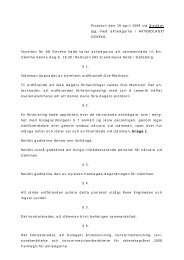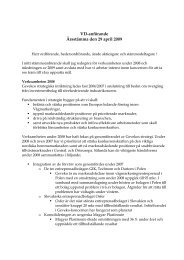PDF Document 2.46 MB - Geveko
PDF Document 2.46 MB - Geveko
PDF Document 2.46 MB - Geveko
You also want an ePaper? Increase the reach of your titles
YUMPU automatically turns print PDFs into web optimized ePapers that Google loves.
Financial Reports / Accounting and valuation principlesThe minority interest in net assets valued atfair value is included in Minority interests,which is stated on its own line with in Equity,in connection with the creation of the Grouprelationship. Minority interests are thereafteradjusted to include the minority’s interest inthe result for the year and other changes inreserves.Accounting treatment ofassociate companies IAS 28Companies that are not subsidiaries, butover which the parent company has a significantdirect or indirect influence, whichnormally means control over 20-50% of thevotes, are stated as associate companies.In the consolidated financial statements,interests in associate companies arestated in accordance with the equity interestmethod, whereby the shares in the associatecompany are stated at their historic cost atthe time of acquisition and then adjusted forthe Group’s interest in the change in the netassets of the associate company. The value ofthe shares includes goodwill and otherexcess value (after deduction of accumulateddepreciation) arising on the acquisition.The Group’s interest in the profit/lossof associate companies after the time ofacquisition is stated in the consolidatedprofit and loss account, and its interest inchanges in reserves since the acquisition isstated among Reserves. Accumulatedchanges since acquisition are stated as achange in the book value of the holding.When the Group’s interest in an associatecompany’s losses amounts to or exceeds itsholding in the associate, including any un -secured receivables the Group ceases to stateany further losses, unless it has acceptedcommitments or executed payments onbehalf of the associate.Unrealised profits on transactionsbetween the Group and its associate com -panies are eliminated in relation to theGroup’s interest in the associate company.Unrealised losses are also eliminated, exceptwhen the transaction serves as evidence ofthe need to impairment of the transferredasset. The accounting principles for associatecompanies have been changed in relevantcases to guarantee consistent application ofprinciples within the Group.Interests in the earnings of associatecompanies are stated in the parent company’saccounts at historic cost. Only the dividendreceived from the earnings generated sincethe acquisition is stated as income fromassociate companies.The after-tax result from associatecompanies is included in the operating result,since associate companies are considered toconstitute part of Industrial Operations.The <strong>Geveko</strong> Group had no interests injoint ventures during the financial year.Foreign currencies IAS 21Functional currency and reporting currencyItems in the financial reports of the variousunits in the Group are valued in the currencyused in the economic environment whereeach unit largely conducts its business (functionalcurrency). For all companies in theGroup, the functional currency is identical tothe currency of the country where it is active.The currency used in the consolidated financialstatements is the Swedish krona, whichis the parent company’s functional currencyand its reporting currency.Transactions and balance sheet itemsTransactions in foreign currencies are translatedinto the functional currency at theexchange rates applying on the transactiondate. Currency profits and losses arising inconnection with the settlement of suchtransactions and in the translation of monetaryassets and liabilities in foreign currenciesat closing date exchange rates are stated inthe profit and loss account. Exceptions aremade when the transactions are hedges thatsatisfy the conditions for hedge accountingof cash flows or of net investments, in whichcase profits/losses are stated within equity.Translation differences arising on nonmonetaryitems, such as the valuation ofshares at actual value across the profit andloss account, are stated as part of theprofit/loss on valuation at actual value.Group companiesThe result and financial position of allGroup companies (none of which use ahigh-inflation currency) that have a differentfunctional currency from the reportingcurrency are translated into the Group’sreporting currency as follows:• Assets and liabilities for each of the balancesheets are translated at closing date ex -change rates.• Income and costs for each of the profitand loss accounts are translated at averageexchange rates for the year.• All currency differences arising are statedamong Reserves within Equity.Upon consolidation currency differencesarising as a result of the translation of netinvestments in foreign businesses and ofborrowing and other currency instrumentsthat have been identified as hedges for suchinvestments, are taken to Equity. Upon thedivestment of a foreign business such currencydifferences are stated in the profit andloss account as part of capital gains/losses.Goodwill and adjustments to fair value arisingon the acquisition of a foreign businessare treated as the assets and liabilities of thebusiness in question and translated at closingdate rates.Accounting treatment ofincome IAS 11, IAS 18Accounting treatment of incomeby Industrial OperationsProduct salesProduct sales are recognised as incomewhen risks and benefits are transferred tothe buyer, which is normally upon delivery.Sales are stated net after value added tax,rebates and discounts, and currency differencesin the case of sales in foreign currencies.Contracting activitiesContracting work in progress is largely ofshort duration, and is invoiced on accounton a weekly or monthly basis.In the case of contracts performed overlonger periods of time the income and costsattributable to the contract are recognised asincome and costs respectively pro rata inrelation to the degree of completion of thecontract on the closing date (successiverecognition). A contract’s degree of completionis determined by comparing the costsincurred on the closing date with the estimatedtotal costs.In cases where contract costs cannotbe estimated reliably, income is only recognisedto an extent that corresponds to thecontract costs incurred that will probablybe reimbursed by the customer. If a loss isexpected on a contract this is recognisedimmediately as a cost.At the end of each year, there are fewuncompleted contracting activities that havenot been recognised in the result.Other income that is earned is recognised asfollows:• Royalties and the like: in accordance withthe financial implications of the relevantagreement.• Interest income: in accordance with theeffective yield.• Dividends: when they become due forpayment.Recognition of incomefrom the Securities PortfolioThe Securities Portfolio of listed equities,options and other shares and capital interestsis classified as “valued at fair value via theprofit and loss account” in accordance withIAS 39 (see also Financial Instrumentsbelow). Each item in the portfolio is valuedindividually at market value. The differencebetween the opening and closing values ofthe portfolio is stated under “Income fromsecurities” in the profit and loss account.Transactions within Management ofSecurities are stated on the day the transactiontakes place, at which time risks andbenefits are transferred to the buyer.60
















